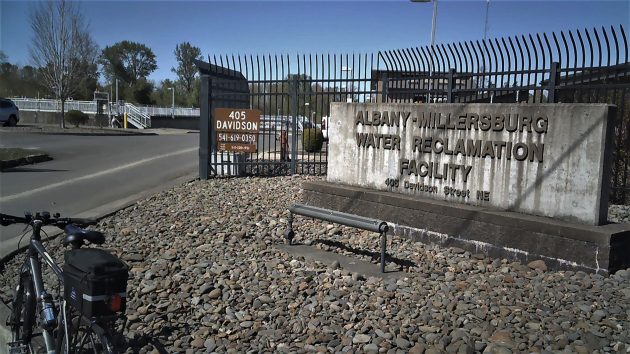
Outside the treatment plant on April 15. A solids-composting installation will be built there.
Every few years I take a new photo outside Albany’s sewage treatment plant to illustrate yet another step in the city’s long-running struggle to overcome the fact that part of it doesn’t work.
Last week, the Albany City Council awarded a $6.9 million contract to build a facility at the plant to compost a portion of the solids produced in the treatment process. Improvements in the plant’s dewatering equipment are part of the contract, awarded to Pacific Excavation Inc. of Eugene, whose bid was the lowest of six.
The compost facility is intended to turn 25 percent of the plant’s solids into a usable soil amendment. It will include equipment to “capture and treat odors,” which no doubt is hopeful news to the riverside neighborhood.
The contract says construction is supposed to be complete no later than Sept. 30, 2022.
Albany, with Millersburg as a minority partner, completed the sewage treatment plant in 2009 at a cost of $70-78 million, depending on what was counted as being included.
It was built around a new system to handle the solids, but as soon as the plant was finished, the system its makers called “Cannibal” proved not to work as intended. The city has been trucking solids to the Coffin Butte landfill, at a cost previously reported as $650,000 a year.
Albany sued Cannibal’s manufacturer and reached a $4.75 million settlement in 2012. At the time the city received engineers’ estimates that the problem could be fixed for $5 million. Later those estimates rose to $10 million, but a solution proved elusive until consultants suggested composting.
That’s the solution the councils of Albany and Millersburg agreed to pursue in 2018, on a small scale at first. A full-scale composting plant to handle all the solids would cost $27 million to build and operate for 20 years, officials said at the time.
When the compost facility now under contract is finished, city officials presumably will figure out where to build a bigger one that can handle not just 25 percent but all the solids. That will be be a few years down the road. Until then, most of the undigested sludge will keep going to Coffin Butte.
In December 2017, Albany sued the designers of the treatment plant, claiming $84 million in damages for the treatment plant and the Talking Water Gardens, which also has developed problems. The suit remains pending in court. (hh)

thanks for your comprehensive update and history lesson. Another lesson learned in another venue–the “experts” opinions are often wrong.
What is the cost of dumping at coffin butte?
The city is budgeting $1.5 million over the next two fiscal years for this expense.
I foresee a hike in my water bill yet again!
3.5% water, 3.5% sewer, 17% stormwater, in the next couple years W/S drops to 3% increases but the stormwater goes up exponentially. Average bill this round, $133, about 31% higher than Corvallis, they didn’t compare to Lebanon in the presentation, then you have the utility tax on the horizon. You’re going to have a water bill equal to some property tax bills in the not too distant future including the number of line items with amounts attached. It’s going to be expensive to live in Albany, Oregon.
Here is the Progressive playbook on how cities like Albany can increase revenues.
https://localprogress.org/wp-content/uploads/2013/09/Municipal-Revenue_CPD_040815.pdf
Albany will need to ask for an exception – the playbook includes eliminating Tax Increment Financing (CARA).
I would like to preemptively thank everyone for not using one of the usual puns related to sewage and sewage treatment.
I heard that to work at the Albany facility you first had to read the book “On the Origin of Feces.”
Can you confirm?
I think most of it comes from you, Gordon.
Well damn, I’m gonna go out in my backyard & dig a privy! Or, make a seat frame to go over the sewer lid out front & just let it hang out. Or. pick out the City councilor of the week & make a deposit in their yard…..pay backs…… Guess I could stop eating & just go with liquids & whiz in the street gutter. My slyness of words makes as much sense as the Councils efforts.